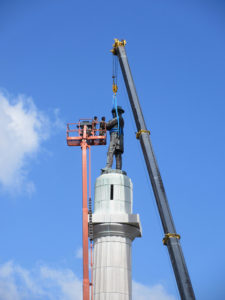Deconstructing Hate: False Southern Prophets Fall in New Orleans
 Workers prepare to remove a statue of Robert E. Lee in New Orleans, LA. (Photo by Infrogmation via Flickr)
Workers prepare to remove a statue of Robert E. Lee in New Orleans, LA. (Photo by Infrogmation via Flickr) Last week the mayor of New Orleans, Mitch Landrieu, visited the Center for American Progress (CAP) and joined CAP President and CEO Neera Tanden for a conversation on race in America.
Landrieu focused primarily on his efforts to remove historical Confederate monuments from the city of New Orleans—four specific statues, in fact: tributes to Robert E. Lee, Jefferson Davis, P.G.T. Beauregard, and the Battle of Liberty Place. The process of taking the statues down hasn’t been easy. People got angry about it—really angry. According to local news sources, much of the deconstruction had to take place at night for safety reasons due to threats of violence.
“We did this thing in the middle of the night,” Landrieu told Rachael Maddow in April, “because of the threats that all of the contractors received. The first contractor we had had his car blown up.” Even Landrieu himself, the mayor with over three decades of public service, was unable to rent a crane because all the crane operators had all been blacklisted.
So why did Landrieu risk so much to take down four monuments that have stood untouched and virtually unquestioned for decades? Monuments that resemble hundreds of others around the United States? As New Orleans begins its revival, Landrieu believes these monuments have no place in the future of the city. At last week’s meeting he explained:
There is a difference between the remembrance of history and the reverence of it. Monuments that celebrate a fictional sanitized Confederacy but ignore the death, the enslavement, and the terror that it actually stood for are an affront to our true history. They are wrong: morally and factually.
Given the city of New Orleans’ legacy as the county’s largest slave market, Landrieu believed deconstructing the monuments was the only option to move forward from that dark time in history. But that darkness still exists and Landrieu urges white folks to find our compassion and empathize with the young black mother who must walk past those Confederate monuments every day, reminded of whom her city really idolizes and who her city forgets. Landrieu asked those in attendance at the Center for American Progress to think about the monuments from the perspective of an African-American mother and father. He questioned how they could explain to a young black child that the Confederate figures, immortalized by the statues, were “heroes.”
There’s no way you can look at that little girl in the eye and convince her that Robert E. Lee is there to encourage her. There’s no way for anyone to think that she’s going to feel inspired or hopeful by his story or how he got up there, and why he’s still there after all of this time.
It would be naïve to think that racism would disappear once its symbols do, but that’s not Landrieu’s point. The mayor’s bigger picture is this: if we rid our surroundings of these negative symbols of hate, racism, and violence, we can stop empowering white men and women to continue the false idea of supremacy and power over black women and men. We declassify them as heroes to be used as a distraction in debates about racial supremacy and masculinity, and then we finally start to have real, honest conversations about race, without falling back on false southern prophets like Lee, Davis, and Beauregard.
“If we take down the symbols that celebrate white supremacy and hate, and begin to change the attitude, we can finally start to really deal with the issue of race,” Landrieu said. “It will allow us to address poverty, it will allow us to address jobs, it will allow us to address violence.”
